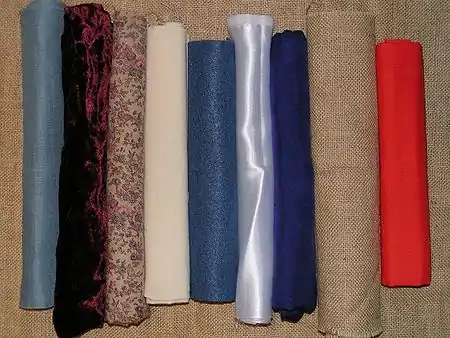
Terms
Preparing Fabric
Always wash and press all fabric before sewing with it. New fabric will usually shrink a certain amount. Marking of patterns must be done on quite flat (well-pressed) fabric, as creases will distort the shape of the chalked pattern.
Types of Fabric
There are two groups of fabric, natural and synthetic. Synthetic fabrics are man made, while natural fabrics are either from a animal protein, like silk or wool, or a plant fiber, like cotton or linen. Fabrics can either be knit, or woven.
Natural fibers
Natural fibers are known to be more expensive than synthetic, but can drape beautifully and keep one cool in a way that synthetic fabrics often cannot.
Cotton Muslin
It is recommended that beginner in sewing get started with a cheap natural fiber such as cotton muslin. This is un-dyed unbleached cotton that is useful for making mock-ups and undergarments. It is a woven fabric so it has little stretch.
Cotton Jersey
Cotton jersey is a knit fabric. It is stretchy, soft, and does not wrinkle or pucker. It is another good beginner fabric, however it can be pricy. Its often used for activewear.
Cotton Flannel
Cotton Flannel is a warm, soft, medium weight fabric. Its weave is loosely spun. It's good for cold weather clothing.
Linen
A type of woven fabric made out of the flax plant. Very good for keeping cool in summer.
Wool
Wool is a protein fabric made from the hair/fleece of camels, goats, alpacas and other animals. It's very good for cold weather.